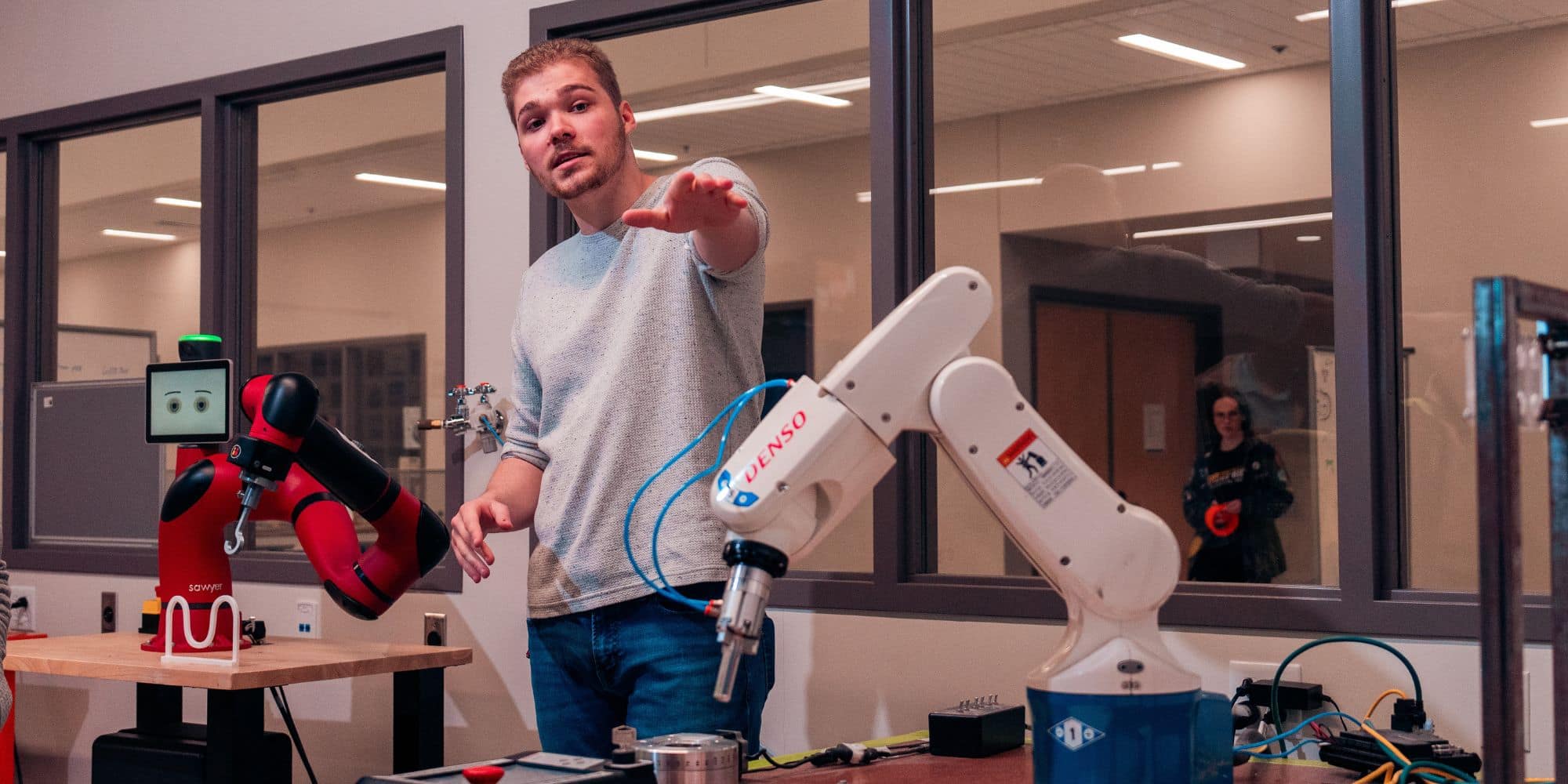

Want a Career in Robotics? Embry-Riddle Can Help You Achieve Your Goals

How Does Robotics Fit Into CESE?
Both the Bachelor of Science in Computer Engineering and the Bachelor of Science in Electrical Engineering offer a specialized robotics track that allows CESE students to get hands-on experience in the Space Robotics Lab. Students gain an understanding of robotics through the lens of electrical and computer engineering, building on their degree coursework involving microcontroller organization and programming.
In this track, students develop extensive programming skills to operate autonomous robots and later complete a multidisciplinary capstone project involving Mechanical, Electrical and Computer Engineering students. Electrical and Computer Engineering students contribute their extensive skills in robot programming during the capstone project.
Because the robotics track is offered in both degrees, students take the same courses and can focus on which degree fits best with their interests, skills and goals when choosing a major. Whichever degree you choose, robotics will be a focal point!
Learn more about how to choose your CESE degree.
Students will likely begin engaging with robotics coursework in their third year, according to the suggested plan of study. This plan includes:
- Introduction to Robotics I: Students learn foundations of robotics, including sensors and actuators, microcontroller integrations, autonomous systems programming and mobile robot manipulations.
- Robotics II: This course builds on Robotics I, providing an advanced understanding of robot programming and movements, including dynamics and control systems.
- Robotics II Laboratory: Integrating hands-on experience, this course allows students to use the knowledge they’ve gained in class on real systems.
- Preliminary Design for Robotic Systems with Laboratory: The first of two capstone courses groups students together to create and design a robotic system.
- Detail Design of Robotic Systems with Laboratory: The second capstone course takes designs and makes them reality — students build and test a robotic system before graduation.
Beyond Academics
Robotics students remain active on campus, joining student organizations that center around designing and building robotic systems. One organization, VEX Robotics, works towards an annual competition against other universities. The group is divided into two teams, ERAU Blue and ERAU Gold. Each one has a programming team and a build team, giving students a wide range of opportunities to enhance their skill set.
Eagle Robotics, another student organization, is housed in the Space Robotics Lab, where students are encouraged to build their existing skills through personal and team robotics projects while also broadening their horizons. Weekly meetings provide students with new learning opportunities and experience with 3D printing, computer-aided design, mechatronics and more.
Students at the Prescott and Daytona Beach campuses have also participated in innovative research projects, some of which have received university funding through the Summer Undergraduate Research Fellowship (SURF) program. These projects include a jumping-type dynamic climbing robot for accurate inspection and testing of the environment, cleaning robots for residential solar panels, wearable exoskeleton robots, an Embry-Riddle Campus Ambassador robot and a robotic dog for research and education.
A Career Meant for You
Because the field of robotics is fast changing, there are many opportunities for your unique skill set and interests. According to institutional research, Embry-Riddle alumni are employed at Collins Aerospace, General Motors, Honeywell, L3Harris Technologies, Lockheed Martin, Northrop Grumman, Raytheon, Sierra Nevada Corporation and more.
Alumni are also engaging in different roles within these companies — these are just a few of the opportunities that a degree from Embry-Riddle can set you on the path to achieve.
Computer Engineering
- Electronic Systems Engineer
- Systems Integration Engineer
- Software Engineer
Electrical Engineering
- Electrical Engineer
- Hardware/Software Design Engineer
- Test Systems Engineer
Looking to learn by the beach? See if the Department of Electrical Engineering and Computer Science (EECS) at the Daytona Beach Campus is right for you.
CESE partners with the Department of Mechanical Engineering (ME) to bring recently reinvigorated robotics curriculum for Computer and Electrical Engineering majors. Faculty encourage and engage student involvement in cutting-edge research activities on campus.
Students who choose to work toward a degree in Mechanical Engineering work alongside CESE students in coursework, extracurricular activities and beyond.
At Embry-Riddle, you’ll be surrounded by like-minded students who will push you in the right direction through mutual support and friendly competition. And whether you opt for a degree in Computer or Electrical Engineering, Embry-Riddle is the place to be — especially when it comes to robotics.
Insights
 Worldwide College of Aviation Associate Professor Dr. Linda Vee Weiland shares insights and knowledge on the air traffic industry.
Worldwide College of Aviation Associate Professor Dr. Linda Vee Weiland shares insights and knowledge on the air traffic industry.
How to Become an Air Traffic Controller Explore human factors psychology, a field that blends psychology, engineering and design to improve safety, efficiency and user experience.
Explore human factors psychology, a field that blends psychology, engineering and design to improve safety, efficiency and user experience.
What is Human Factors Psychology Learn how to become an aerospace engineer at Embry-Riddle Aeronautical University. Discover diverse careers, hands-on experiences and specializations in the aerospace industry.
Learn how to become an aerospace engineer at Embry-Riddle Aeronautical University. Discover diverse careers, hands-on experiences and specializations in the aerospace industry.
How to Become an Aerospace Engineer




